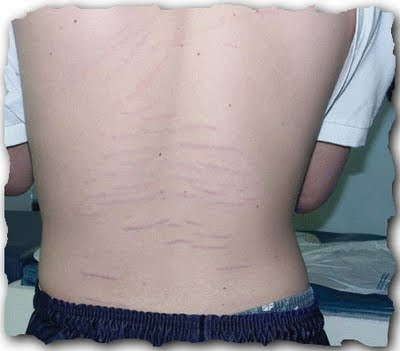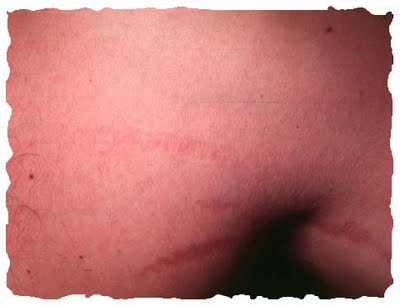Please tweet and retweet
Tweet
The medical term for stretchmarks is striae (stria for a single stretchmark). They also referred to as tiger stripes. Skin with stretchmarks has been studied under the microscopic as far back as 1889. Every adult knows what they look like. They can be caused by rapid mechanical stretching of the skin or by hormones made by the body or taken externally. They can most frequently be found on the abdomens of women of have been pregnant (striae gravidarum) and on the shoulders of teenage body builders (striae distensae). They are also seen in overweight individuals, after rapid growth during puberty and adolescence, in people with Cushing's syndrome, after topical or prolonged treatment with steroids and on the breasts after breast augmentation or pregnancy and subsequent breast feeding. The combination of rapid growth in the early teen years and excessive weight gain is sure to result in stretchmarks.
As pregnancy progresses the breasts engorge/enlarge in preparation for breast feeding after delivery. Once breast feeding is completed they can shrink back down in size or deflate and in some cases even become smaller than they were before the pregnancy. The degree of drooping that results depends on the difference in size between when they are the largest and when they have shrunk down in size. The appearance of stretchmarks is proportional to the size they reach during engorgement. Sometimes a breastlift or breast implant is required to improve the look but these should not be done until at least one year after stopping breast feeding. In other cases the stretchmarks may be less visible on the deflated breast and more visible after placing breast implants to re-inflate the breasts.
--------------------------------------------------------------------------------------

--------------------------------------------------------------------------------------

---------------------------------------------------------------------------------------

--------------------------------------------------------------------------------------

-------------------------------------------------------------------------------------

-------------------------------------------------------------------------------------
The factors that contribute to stretchmarks of pregnancy are family history of stretchmarks, younger age of mother (women in their 20s), greater weight gain during pregnancy, and larger infant birth weight and older gestational age at delivery. They tend to appear in the last 3 months of pregnancy when skin stretching is maximal and the skin has had prolonged exposure to the hormones of pregnancy. Many people claim the application of cocoa butter will prevent these stretchmarks but this has never proven to be the case. In fact, a randomized, double-blind placebo controlled trial of 300 pregnant Afro-Caribbean women in Jamaica and another with 210 nulliparous women in Lebanon found that cocoa butter cream does not prevent stretch marks from pregnancy. There is some evidence though that topical vitamin E can be preventative. This is most likely because it acts as antagonist to the hormones that contribute to stretchmark formation. One has to be careful though because I have seen patients develop allergic skin reactions after prolonged application of available topical vitamin E preparations. Retin-A has a similar effect on stretchmark prevention but cannot be used during pregnancy because it can cause deformities in the baby. It therefore is only of preventive use in the bodybuilder etc. Ironically a woman may not develop stretchmarks after the first baby but then do so after the second.
At a microscopic level we see alignment of collagen fibers into parallel sheets rather than the normal random orientation of the fibers present in normal skin. Also, there is a flattening of the normally wavy or sinusoidal junction between deep and superficial skin. This makes the stretchmark skin more susceptible to shearing forces so if you pulled at the skin it would disrupt along the striae first. In fact in morbidly obese patients with hanging abdominal skin when I look under the fold of skin I see striae and if large enough the weight of the excess tissue partially tears the skin open along the striae.
An evolution of these striae has been noted. They start out flat with a faint pink color and sometimes itch. Overtime they widen, lengthen and darken in color. After several years they fade whiten and become depressed. When the stretchmarks are pink a flashlamp laser can be used to lessen the redness and this makes them less noticeable but this laser can depigment darker skin. More recently fractional CO2 laser has been shown to stimulate collagen production within the stretchmarks and yield some visible improvement. Radiofrequency application has shown similar results but the degree of improvement is less. Collagen induction therapy (CIT) involves the application of a roller with multiple small needles to the skin surface. The resulting holes in the skin without damage to the skin surface are believed to stimulate collage production. As of this writing the only thing that has been proven is that CIT does not alter skin pigmentation and may be of use in skin rejuvenation. There is no proof at present that it improves stretchmarks. Further study of CIT is required before it can be recommended. Others have tried chemical peels. None of these treatments has been able to erase stretchmarks and multiple applications are usually required before any result is seen.
The only treatment that consistently removes stretchmarks is an abdominoplasty or tummy tuck but this only works for stretchmarks below the belly button.
 This patient had stretchmarks after pregnancy that extended up past the belly button to the rib cage and many around the belly button. I removed those below the belly button by abdominoplasty but was only able to move the upper abdominal stretchmarks downward. Sometimes the pulling on the skin by the surgery makes the few remaining stretchmarks more visible.
This patient had stretchmarks after pregnancy that extended up past the belly button to the rib cage and many around the belly button. I removed those below the belly button by abdominoplasty but was only able to move the upper abdominal stretchmarks downward. Sometimes the pulling on the skin by the surgery makes the few remaining stretchmarks more visible.-----------------------------

 This patient had stretchmarks confined to the lower abdomen below the belly button. In this case I was able to remove all of the stretchmarks at tummy tuck surgery.
This patient had stretchmarks confined to the lower abdomen below the belly button. In this case I was able to remove all of the stretchmarks at tummy tuck surgery.
Addendum February 20, 2016:
A just published study of non-ablative fractional lasers (Icon1540nm Erbium Laser, Cynosure and Emerge1410nm Diode Laser, Cynosure) applied over 6 sessions at 3 to 6 week intervals to abdominal stretchmarks showed visible improvement when evaluated 3 months after the last session. Biopsies showed increases in epidermal thickness, dermal thickness and collagen and elastin density after treatments when compared with baseline. 70% of the patients reported being very satisfied with the results.
Abdominoplasty for excess skin and fat and loose muscle
Abdominoplasty for excess skin
Abdominoplasty after weight loss
Belt lipectomy 1
Belt lipectomy 2
Aaron Stone MD - Plastic Surgeon Los Angeles
Dr. Stone's Twitter




Abdominoplasty for excess skin and fat and loose muscle
Abdominoplasty for excess skin
Abdominoplasty after weight loss
Belt lipectomy 1
Belt lipectomy 2
Aaron Stone MD - Plastic Surgeon Los Angeles
Dr. Stone's Twitter



No comments:
Post a Comment